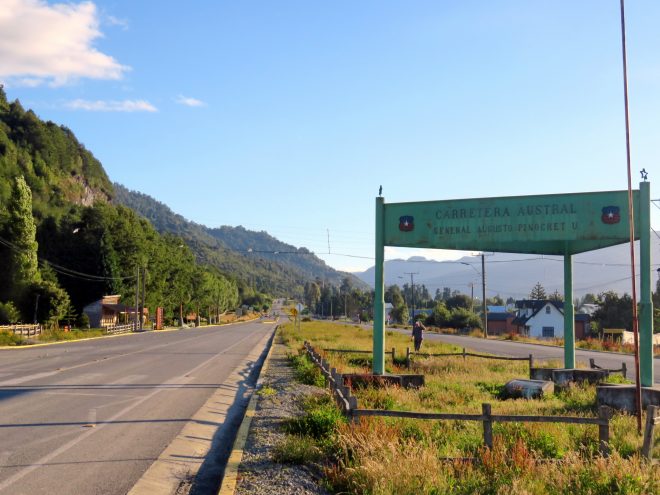Another one of our posts describing the practical side of our cycle trip, this time about the northern Carretera Austral: From Puerto Varas to Puerto Aysén, and back to Puerto Montt through Chiloé.
Table of Contents
The route
The Carretera Austral: From Puerto Varas to Puerto Aysén
We left Puerto Varas in the direction of Puerto Montt, choosing the V-505 road (as opposed to the bigger road 5). It was a Sunday morning, and the road was reasonably quiet until just before Puerto Montt, where a bike path started. We then took a very steep road down to the shopping mall Paseo Costanera, which has a couple of outdoor stores. We didn’t find any more interesting things in Puerto Montt, but we ended up staying there for one night because one of our bags got stolen there (see the section about dangers below). On the next day we took road 7, better known as the Carretera Austral, which officially starts in Puerto Montt. Getting out of the city included climbing a hill in the company of quite some traffic, but once we were back down by the coast again we started enjoying it. We crossed simple villages, which had small shops and cafés and a few nice places to stop and enjoy the view.
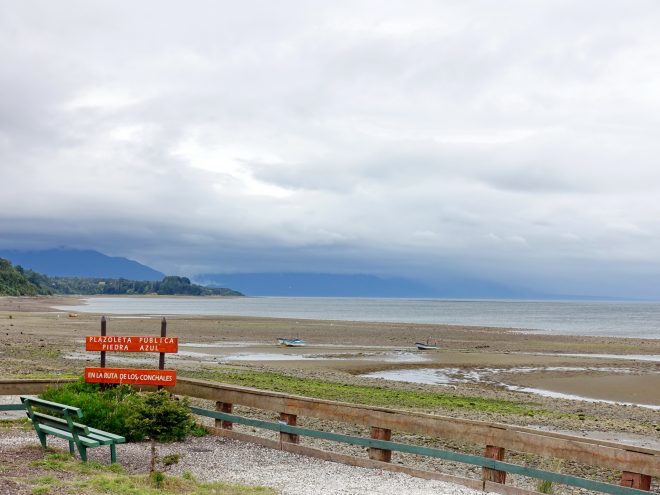
In Caleta la Arena we took the first of several ferries that link the pieces of the Carretera Austral together. This ferry went every half hour, and the short wait was made even shorter by what must be one of the best empanadas place in Chile! It’s called Donde la Pola and is located right by the ferry dock. They make many different and very tasty salty and sweet empanadas.
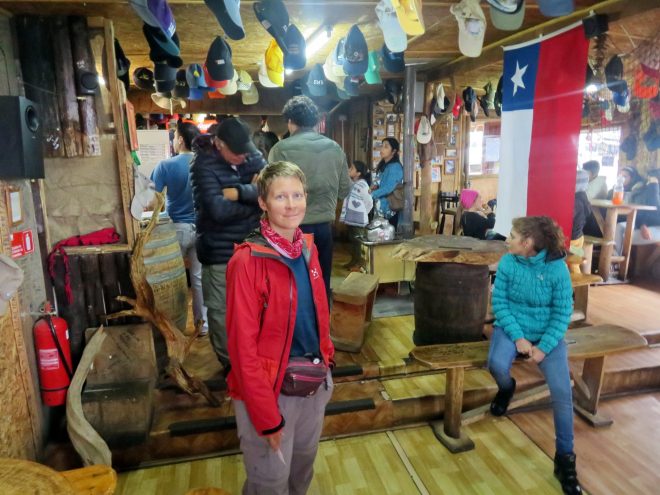
The ferry was packed with cars and trucks carrying fish tanks. We were told that the young fish are bred in one place, and then released into one of the fish farms along the coast.
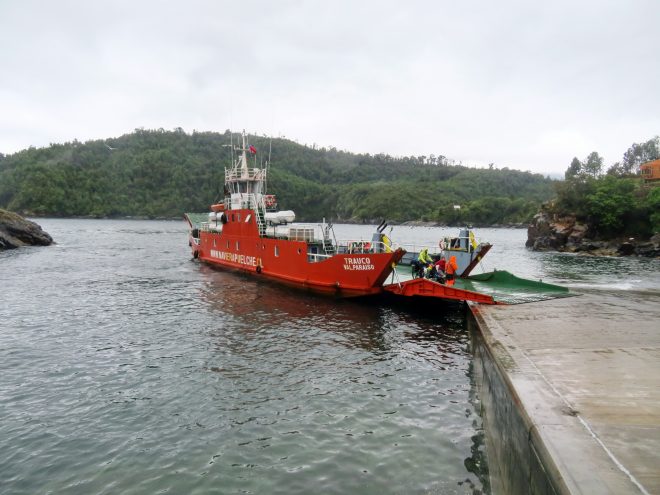
We continued cycling to Contao, a small village, after which the road became non-asphalted. This came a bit as a surprise to us, as our warmshowers host in Puerto Varas had assured us that the Carretera Austral was asphalted all the way down to Coyhaique! We don’t know whether she said that to reassure us, but in any case, we now know that this is definitely not true. There were road works going on in some places, but it’s still going to be a long time until all is asphalted.
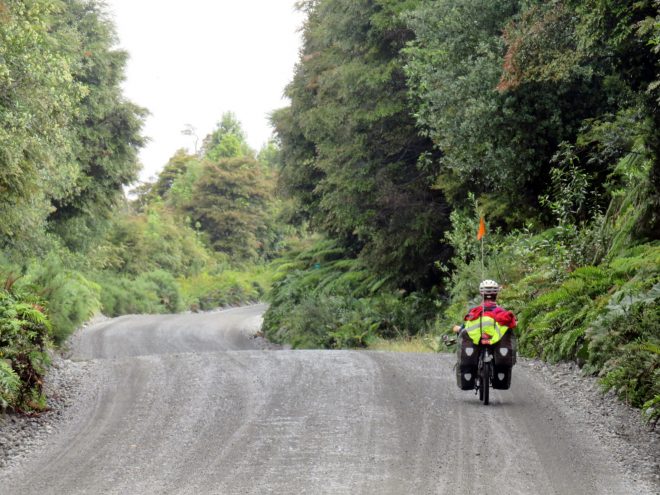
This non-asphalted road continued uphill, which was tough at the end of a long day cycling. We stopped at a small settlement and asked at a place renting cabañas (El Cisne) if we could set up our tent there. We could, but had to pay. The lady asked for quite a steep price (given that we were using no infrastructure apart from the toilets and cold-water taps), which we managed to haggle down to something half-acceptable.
The road to Hornopiren became asphalted again from Pichicolo, where there was also a small campsite. It was the constant rollercoaster up-and-down, so typical of the Carretera Austral. In Hornopiren we had to take another ferry, for which we had looked up the timetable in advance (it left at 12h30 in January 2017). It’s a two-step trip: a first ferry to Leptepú, followed by a 10 kilometre stretch of road (ripio), and a second ferry to Caleta Gonzalo. We were several cyclists on the ferry, and we didn’t see any cyclist turned away for lack of space (we had read some stories about this online). The first ferry left a bit late, so we had only 45 minutes to cycle the 10 kilometres. We made it, but had to pedal like crazy on the (not always good) ripio and arrived exhausted. There was not much on this stretch of road, apart from forest. Other cyclists got lifts on pickups or lorries, but don’t count on it if you’re doing this trip – there were not that many vehicles with space for bikes. We also discovered that there was a direct ferry from Hornopiren to Caleta Gonzalo, which had left at 10h30 in the morning. This would surely have been a more comfortable ride for cyclists…
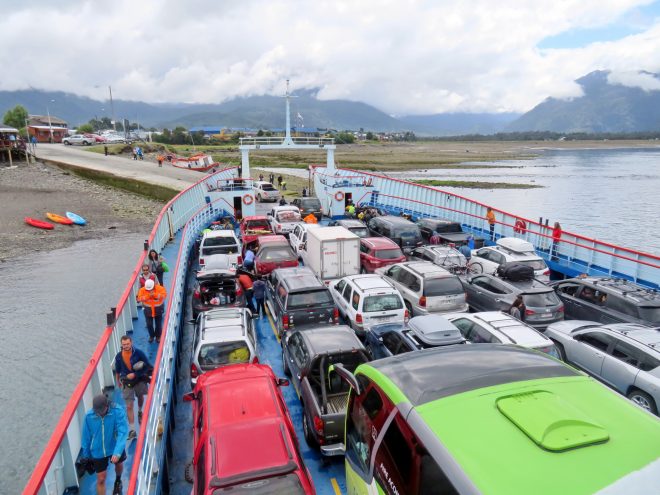
Caleta Gonzalo is the gateway to Parque Pumalín (read more about it on Wikipedia). There was a (mildly useful) tourist information office, a few expensive-looking rental cabañas and a restaurant, but no shop. We spent the night at the beautifully located campsite (which we found a bit overpriced, given that they didn’t have electricity nor warm water, despite the nicely done bathrooms).
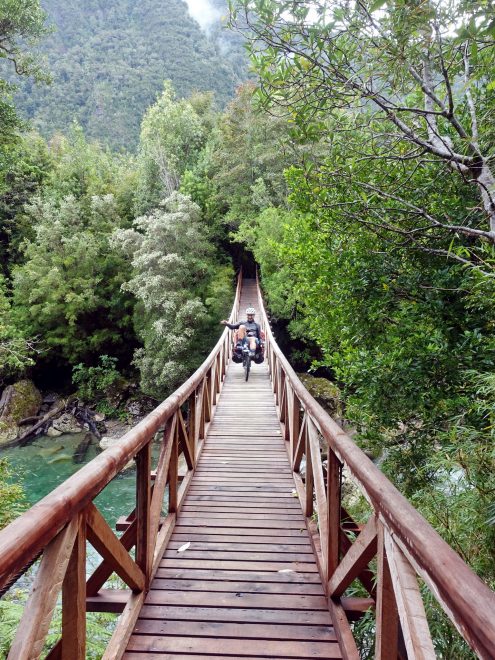
The road to Chaitén was almost all ripio, except for the last bit from the village of Santa Bárbara, where there was also a shop by the road – probably every cyclist stopped there, as it was the first shop for a long time! There were road works being done on the last stretch of ripio, so it’s possible that this road is also being asphalted soon.
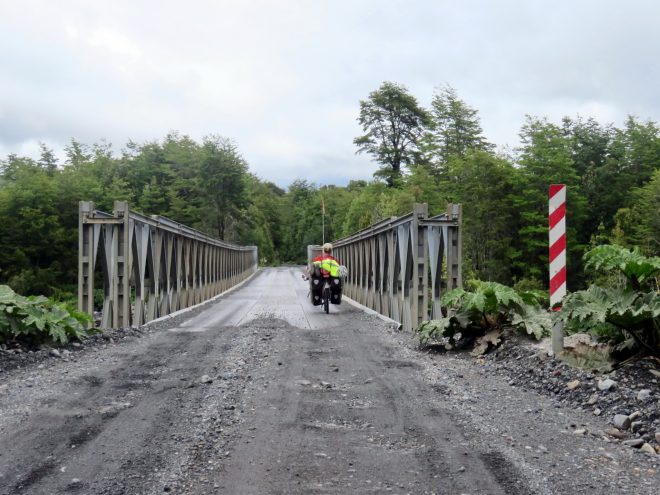
Chaitén had a very touristic feel. The small town is packed with hospedajes, some of them were listed on a map given to us at the tourist information, but there were many more that were not listed. We pedalled around a bit before finding a place. It was very basic, as often in Chile: a room with a bed and nothing else, not even a chair, and nothing to hang up our clothes to dry.
We spent a couple of hours at the Natour café (a café inside an old bus), it was the typical hangout for foreign twenty-something backpackers, which we usually avoid, but we needed a good internet connection to get something done, and we found it there.
The road continued asphalted and in good condition until just after Puerto Cárdenas. We stayed the night in the village of El Amarillo, which has one hospedaje (we had a heated room and very cosy warm beds), but didn’t go to the famous thermal spa, as this would have included another uphill on ripio. We later heard from several people that they enjoyed this spa a lot, so it would probably have been worth the climb.
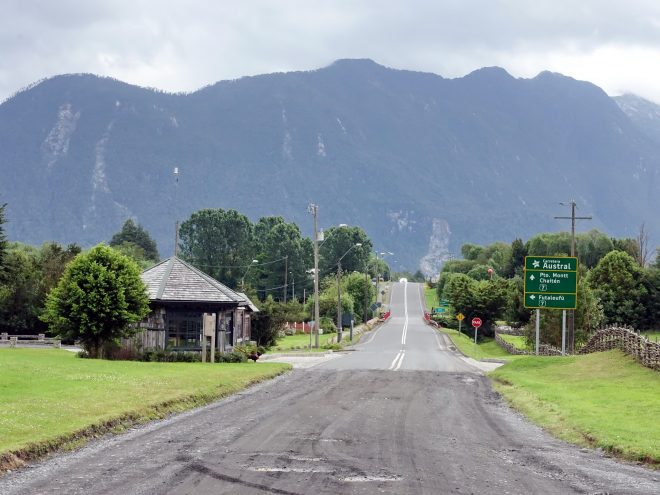
After Puerto Cárdenas, the ripio road climbs up to about 600 metres altitude. This climb was very tough, because there were road works all the way to the top. The road surface was bad and became muddy at the end. The downhill on the other side was already mostly paved. The good news is that in a few months, this stretch of road will probably be completely asphalted.
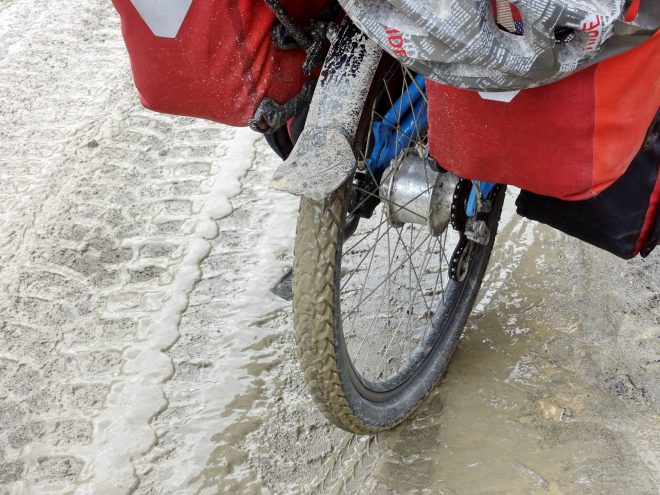
We cycled through Villa Santa Lucia and stopped later at a roadside viewpoint with benches. There was a simple campsite further along the road, but we didn’t stop there either, and cycled on instead until we reached Villa Vanguardia, where we free camped on a nice spot of grass next to the river. We had wanted to stop before, but hadn’t managed to find a suitable place. There was a stretch of ripio before Villa Vanguardia, and a bad stretch of slippery and loose ripio afterwards. But we had our first sunny day, and thus enjoyed the ride to La Junta.
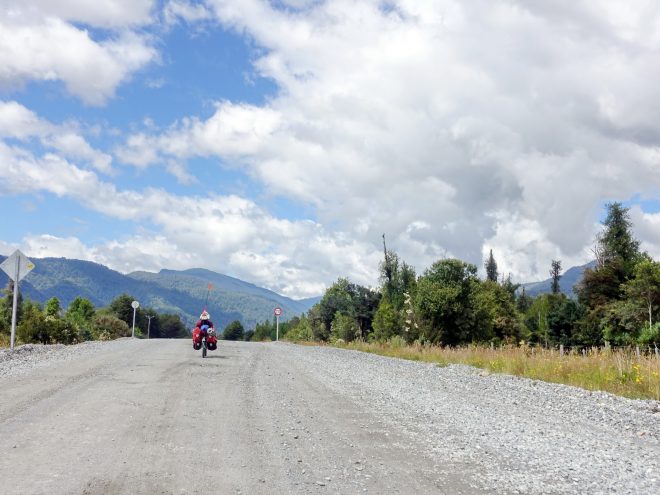
We arrived in La Junta at siesta-time. It took us quite a bit of pedalling around between the three shops to stock up on food, find a bakery that was actually producing bread, and get some information from the (totally un-useful) tourist office. We ended up staying for the night in a cramped camp site, which was in fact somebody’s garden. There was a much nicer looking camp site a couple of kilometres before La Junta, and another one a few kilometres further on (that the tourist office didn’t know about, but it’s marked on OSM).
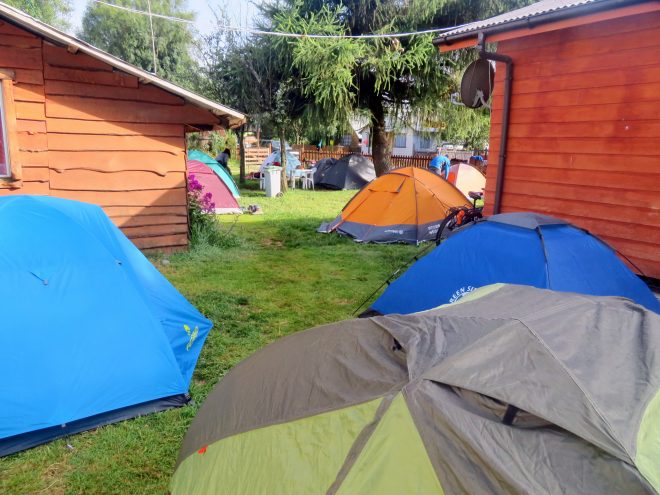
The next day we pedalled to Puyuhuapi, where we arrived in time for our lunchbreak. It was another sunny and very enjoyable day on a winding, quiet and asphalted road. Only the end was made of dusty ripio, and Puyuhuapi itself was very dusty and noisy due to major road works going on in the centre.
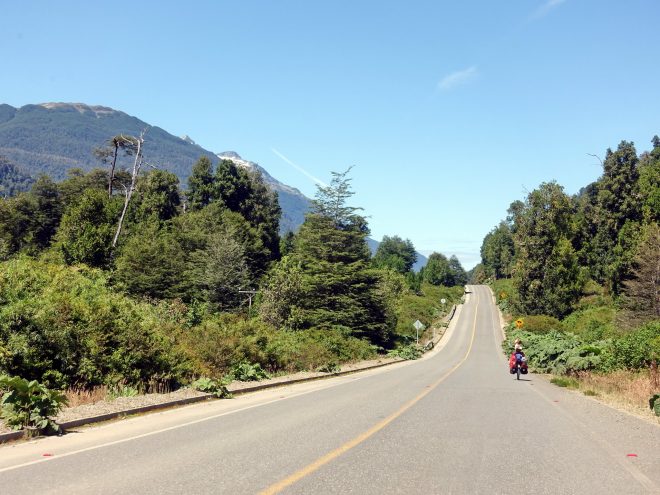
After a long coffee-cum-Wifi break and a shopping tour, we continued to the Termas del Ventisquero, a hot-water spa right next to the road. It was one of the most over-priced experiences of our whole trip. We each paid 18’000 pesos for three or four simple hot water basins by the fjord. There was no proper changing room (I got changed in the shower room, to the embarrassment of the Chilean women who were there at the same time), and they didn’t have any locker keys left for us (but agreed to keep our valuables at the reception desk, and keep an eye on our bicycles).
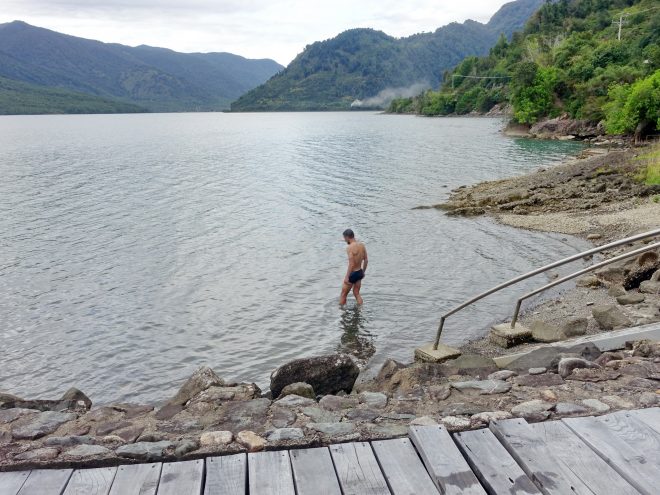
After this hot soak, we cycled another few kilometres until the next camp site (Las Toninas), which was a bit crowded but fine for one night. The next morning, we pedalled into Queulat National Park, where we paid the foreigners’ entrance fee and left our bicycles next to the ranger’s chalet. Despite the cloudy sky, we decided to hike the longest trail to the glacier viewpoint, which took us about an hour on a very muddy path. The weather got worse, and at the viewpoint we couldn’t see more than the lower part of a waterfall and lots of clouds. We waited some time there, but things just got worse, so we went back down.
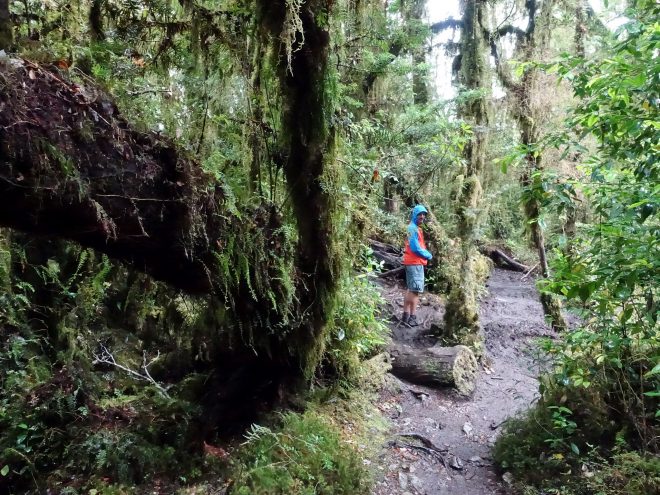
It was pouring down rain when we came back to our bikes. We spent some time in the ranger’s chalet, where there’s an exhibition about the park and a fireplace. By mid-afternoon we realised that things were not going to get better today, so we decided to set up our tent at the local camp site. We sat under the roof of the quincho (a small, roofed-over area with a table and barbecue, common on Chilean camp sites), waiting for the rain to stop while getting colder and wetter by the minute. In the end, we were saved by a Canadian family who had installed their motorhome next to us, and who invited us to eat our dinner with them (plus a bottle of wine, plus ice cream for dessert). By the time we finished our dinner, the rain had stopped and we could set up our tent.
As a reward, we got a view on the glacier on the next day, and we sat on a warm stone by the lake for a while.
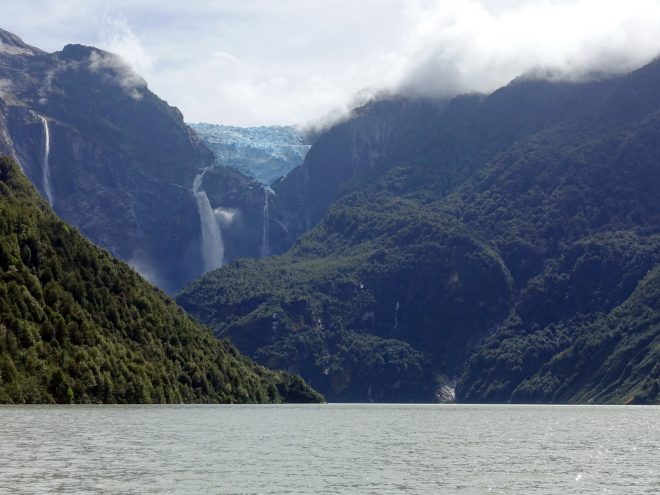
Our next stop was only 10 kilometres away, as we indulged in the luxury of a one-night stay at Posada Queulat – a real gem. After this pampering, we were ready to attack the climb to Portezuelo Queulat, which people had described as steep and horrible. This stretch of road was ripio, but there were also works going on to asphalt it (or part of it). Thus, part of the road was closed for several hours in the afternoon, and there were only few cars. The climb ended up being much less horrible than we had thought. The ripio was well compacted and the road wasn’t too steep. Only the downhill was a bit more difficult due to the loose gravel. We got some nice views on waterfalls from the top, but chose not to visit the “enchanted forest”, which is yet another “pay-for” footpath to a small lake (given the number of cars parked, it must have been very crowded).
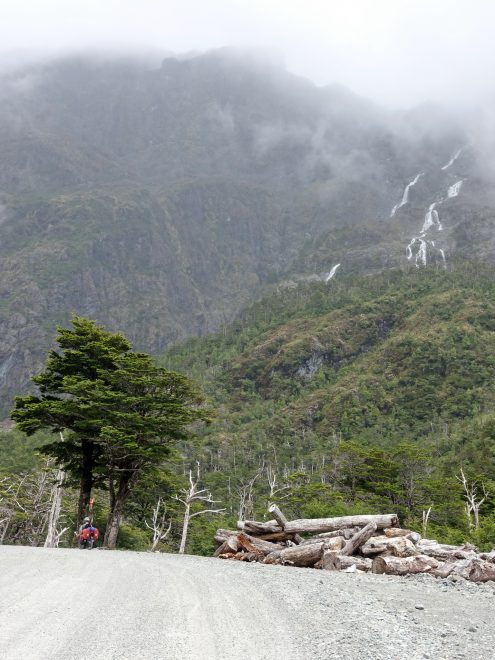
At the bottom of the valley, the road to Puerto Cisnes forks off, and the asphalt was back for good. The road winds through the valley along the river, and there were several viewpoints where we stopped – not mainly because of the view, but because there were benches to sit on.
We also passed a place that we had read about on several cycle travellers’ blogs: a small yellow coffee shop selling – apparently – delicious cakes. We don’t know about the cakes, as it was closed. By the looks of the inside of the hut, it didn’t seem to be open very often, so you better don’t count on it if you’re passing by.
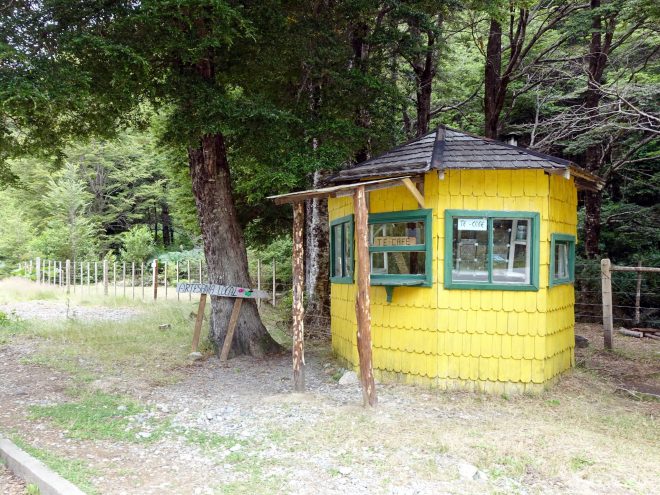
The road then climbs out of the valley, over a hill and down on the other side into Villa Amengual. This small village has a couple of simple shops, a café housed in an old bus (this time it was definitely the non-touristy version), and a family whose garden functions as a camp site (it’s not signposted, but we asked at one of the shops). There was also a hospedaje across the road.
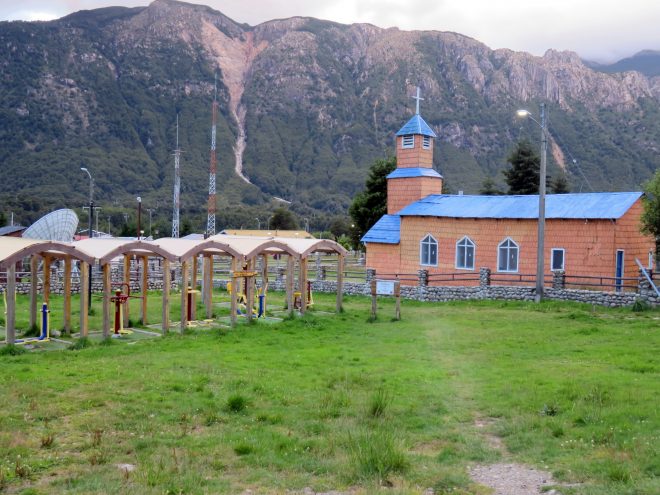
The road continued like this to Villa Mañihuales, winding through narrow valleys in a rollercoaster way, always up and down. It was very quiet, and at times we got this “end-of-the-world” feel that we were all alone on this road (but five minutes later we would encounter yet another cycle traveller).
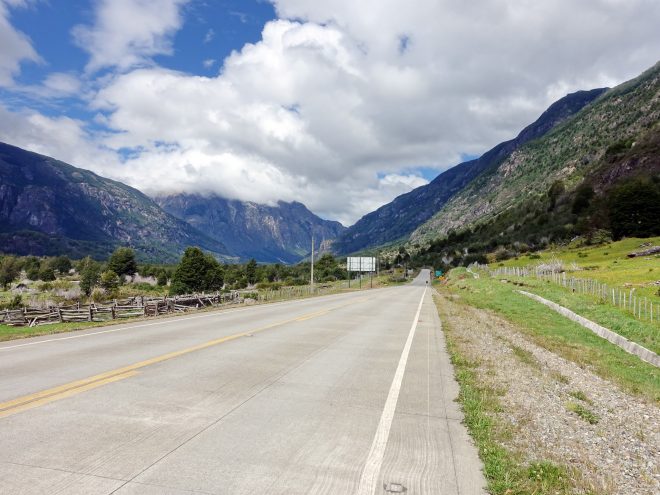
We spent two nights in Villa Mañihuales, relaxing in a nice camp site (BordeRio).
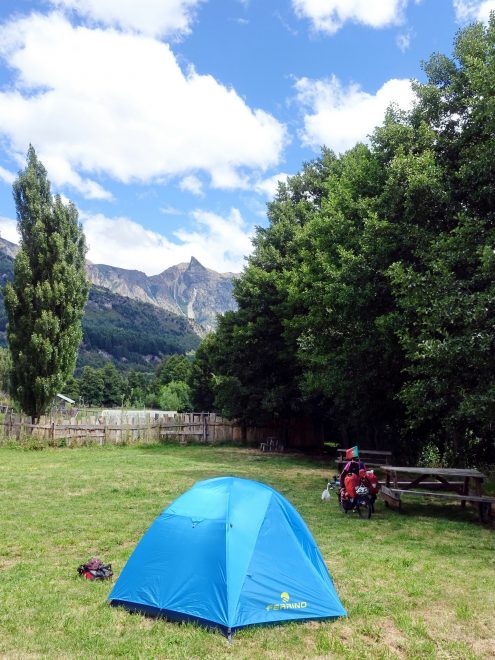
We then pedalled on to Puerto Aysén. The road was still beautiful until we approached Puerto Aysén and the traffic got denser.
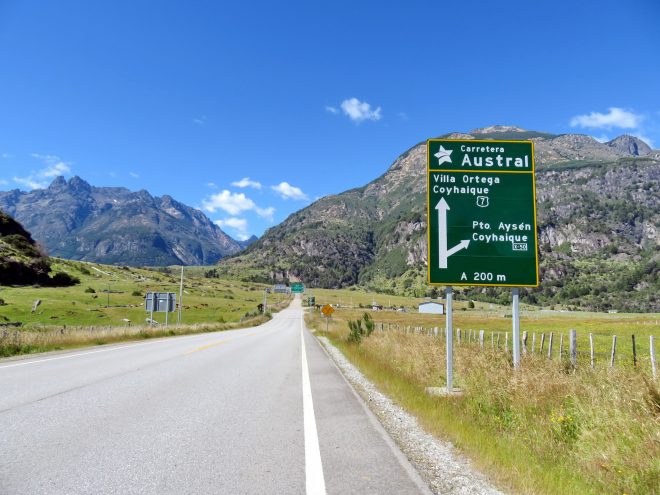
Puerto Aysén itself doesn’t have a ferry port, which is located in Puerto Chacabuco, about 15 kilometres further. We chose to stay in Puerto Aysén while waiting for our ferry’s departure date, because there was only an overpriced hotel in Puerto Chacabuco, whereas there was a choice of several hospedajes in Puerto Aysén. We stayed at Hostal Hudson and were happy about it, although the room was very small (as usual…).
Back to Puerto Montt by the island of Chiloé
We took a ferry from Puerto Chacabuco to Quellón, in the south of Chiloé. We bought the tickets for the ferry online, but could not buy the tickets for the bikes, as the site said that there was no more space for vehicles on the ferry (the reservation site counts bicycles as vehicles). Thus, we arrived at the ticket counter at the ferry terminal at 9 am (opening time), and didn’t have a problem buying tickets for our bicycles.
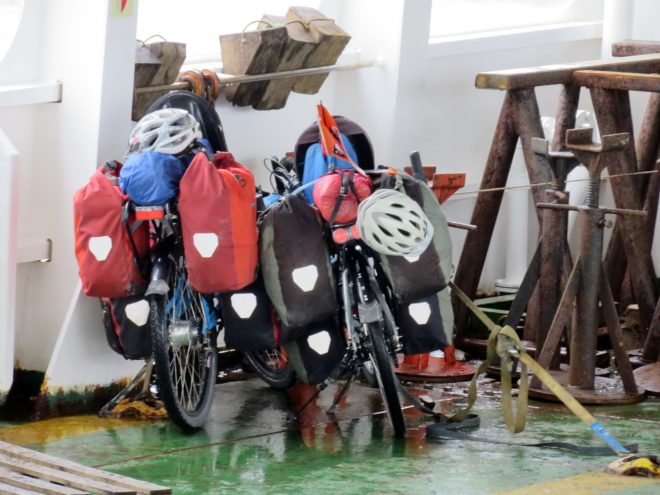
The crossing took 28 hours, and it was beautiful (we were lucky with the weather). The trip was not very comfortable, as there are only seats (such as the ones you get in airplanes) and there was not much space (the ferry got filled up in Puerto Cisnes around 1am). There was a small bar selling (very) simple meals (better bring your own food).
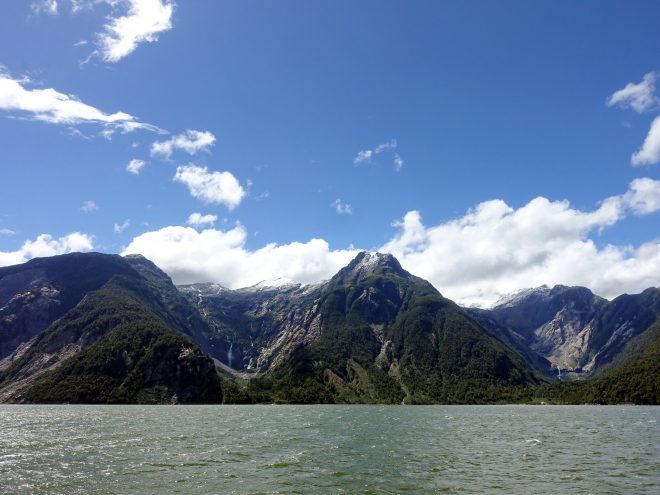
The crossing was quiet as long as we were in the fjords, only when the ferry was crossing over to Chiloé did we get more waves, and many passengers spent the afternoon on the deck with their eyes fixed on the horizon. We landed in Quellón in the late afternoon and pedalled a few kilometres South to Camping Paico’s, where we set up our tent with a beautiful view over the bay and the mountains.
The next day we started cycling on road 5, also known as the Panamericana. This road is all asphalted, and has a hard shoulder most of the time. It also has a lot more traffic, especially trucks. Although we never felt in danger as we did in Argentina, we were nevertheless disappointed. Compared to the Carretera Austral, there was more traffic, the scenery was less special, and the countryside was more densely populated.
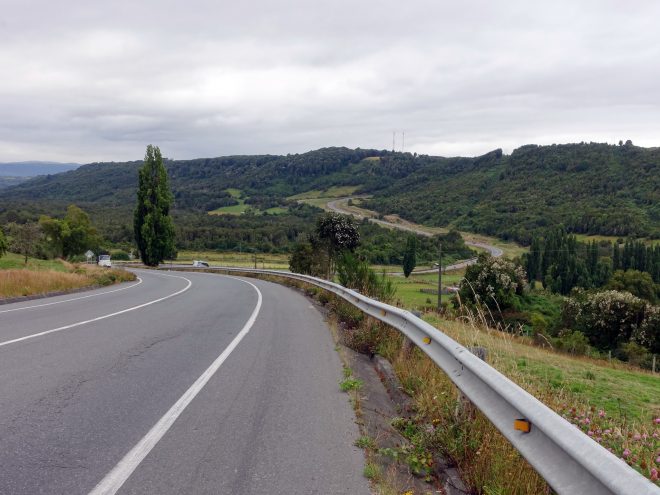
We stopped for one night in a nice camp site next to Lago Natri, and afterwards took a detour to Cucao by taking the rollercoaster road W-80. We had time on our hands and wanted to see the “real” Pacific Ocean. We got rainy and windy weather and didn’t see much of the ocean, though.
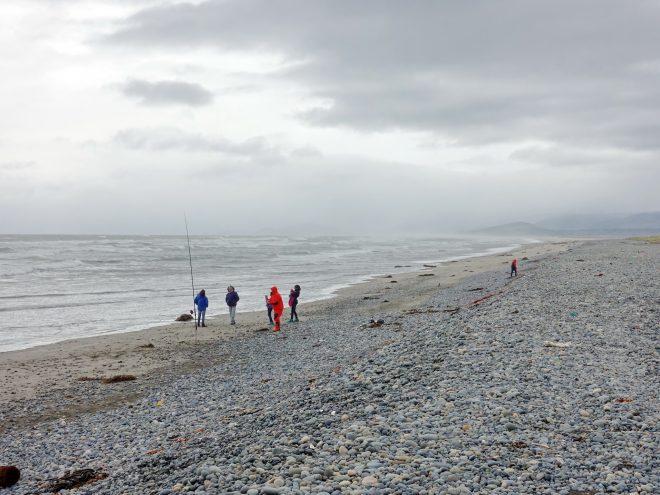
From Cucao we cycled to Castro, where we stayed for two nights and did a bit of sightseeing and visiting. We liked Castro, its colourful houses and lively centre. We were there in time to see a fiesta costumbrista, which was a very nice experience.
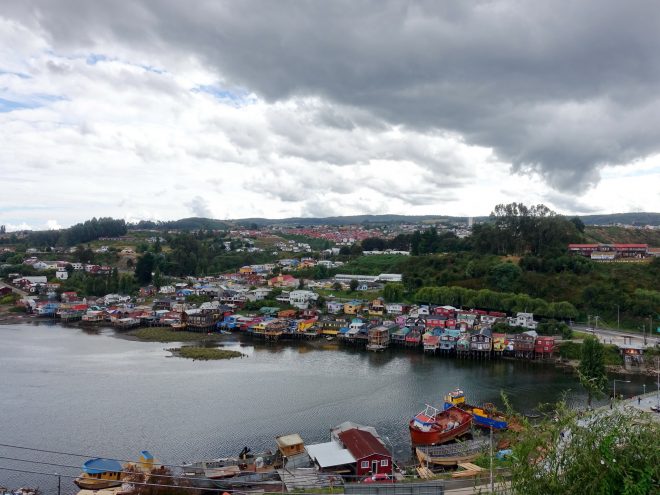
After Castro, we pedalled on to Ancud, on an unmemorable stretch of road which got worse as we approached Ancud, with bad asphalt and no hard shoulder. We slept in an overpriced campsite close to the beach near Ancud and continued to Chacao on the next day. We stopped in this small village to buy some food and get an instant coffee in one of the shops, and then hopped on the ferry taking us over to Pargua on the Chilean mainland.
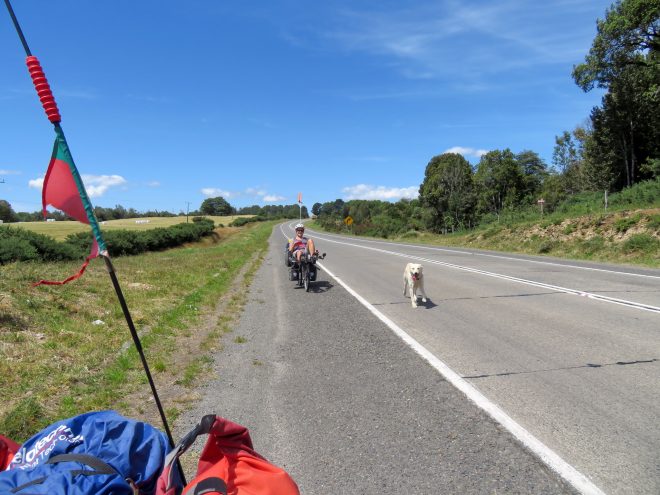
From there, it was all straight to Puerto Montt. Here, the Panamericana is a four-lane highway. Fortunately, there was a very large shoulder for us to ride on, protected from the vehicles speeding past. It was comfortable to cycle, albeit not beautiful nor interesting. There were few places to stop for a break, mostly bus stop shelters, and almost no shops or cafés.
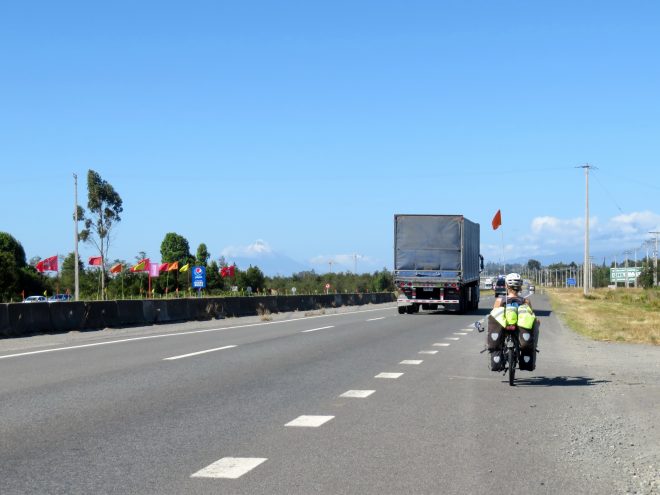
The only interesting sight was an American walking from Ushuaïa to Alaska. He survives with a small backpack plus most of his belongings wrapped around his walking sticks. He made us feel quite small on our bicycles with our four pairs of panniers!
We cycled right into the evening traffic of Puerto Montt. Fortunately, it didn’t take us long to find a nice room – bigger than the usual Chilean hospedaje room – in a quiet neighbourhood, where we stayed for three nights before taking our flight back to Europe.
The drivers and the people
The vast majority of drivers were respectful of cyclists, giving us ample space when overtaking. Compared to Argentina, which has been our worst traffic experience by now, the roads were larger and often had a large paved shoulder. We even encountered a nice cycle path around Lago Llanquihue. On busy roads, we nevertheless needed to concentrate, but we never found it as stressful as in Argentina. On the Carretera Austral, vehicles usually didn’t go fast because of the winding roads and non-asphalted surface. As this region is a popular cycle touring destination, people are also much more used to cyclists.
We found people in Chile more distant than Argentinians, and stricter about rules (as a simplification, you can feel that Argentinians are mostly descendants from Italians, and Chileans from Germans). As an example, we asked in a campground whether we could sit at one of their tables for half an hour to drink some tea and let our clothes dry in the sun – they wouldn’t let us unless we paid the fee for the whole day. However, we only visited a very touristic area where you have to pay for everything, and we are aware that this gives us a limited idea about Chile.
Basic necessities: water, food, sleeping, and other essentials
Water
On the Carretera Austral, water is everywhere: in rivers, lakes, fjords, and falling from the sky. We always got drinking water from camp sites, shops or cafés and never ran out of water. We didn’t use our water filter as we always used tap water, which was good to drink.
Food
Villages often have one or several small shops selling food and all kinds of other things. The selection can be very small though, sometimes limited to sodas, chips and sweets. Despite of this, these shops are usually called “supermercado”. Empanadas and bread are often sold in these shops, too, or from private homes (look out for signs in the window). There is a very small choice of bread, usually small white bread rolls, and the quality is often low (but you can also stumble upon some surprisingly good homemade bread, although wholemeal bread is very rare). “Real” supermarkets are only to be found in bigger towns. We only encountered big, good quality supermarkets in Puerto Montt and Puerto Varas. Restaurants are on the expensive side for what they serve. They usually have a very small choice of fish (salmon and hake, plus some shellfish), and rarely other types of Chilean dishes. Cafés are all over the place, ranging from hip places geared towards tourists, to a corner inside a shop. Coffee is usually the instant version (Nescafé), except in more expensive places catering to tourists, where you can find espresso and caffé latte. Cakes are a common sight, they are called by their German name “Kuchen” in Chile. “Lemon Pai” is another common sweet.
Self-catering is very easy in Chile. Most hospedajes will let guests use their kitchen, which can be a funny experience, when you find yourself cooking between a bunch of locals walking around in the kitchen. The kitchen seems to be the centre of the house, as it’s often the only heated room (woodstoves are still extremely common in Chile). Friends and family come over for chats in the evening, and some hospedajes are lively places because of this. We were a bit intimidated by this at first, until we realised that in these places everybody is welcome and nobody finds it strange that a couple of tourists are cooking their pasta in the middle of it all.
Fuel for cooking (white gas) is easy to get in ferreterías (hardware stores, to be found in towns) and is called bencina blanca.
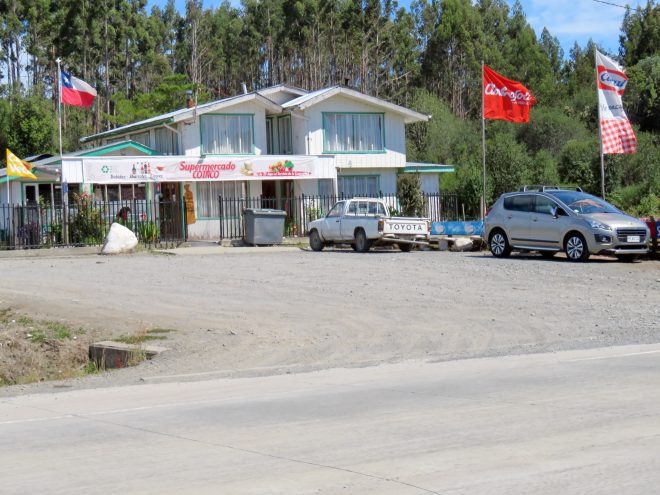
Sleeping
There are many accommodation options all along this part of the Carretera Austral. There are many camp sites, which are often somebody’s back garden. Many camp sites, especially in national parks, only offer cold showers and no electricity, and can feel quite overpriced for what they offer. Guesthouses (hospedajes) and cabañas abound, too. Hospedajes are families renting one or more simple rooms in their house, usually with shared bathrooms. Breakfast is sometimes included and is more complete than in Argentina (bread, butter, jam, cheese, instant coffee and milk). When comparing to other countries (especially Southern Europe), they also feel rather expensive for what they are (i.e. a bleak room furnished only with a bed, and a shared bathroom). It is common to have set hours for hot showers, most of the time in the mornings, although we found this to be negotiable in places using gas to heat the water. We found that prices were usually fixed and not negotiable, whether it was in camp sites or guesthouses.
Money
ATM’s can only be found in bigger towns, so stock up on cash before setting out on the Carretera. Credit cards are often accepted, even in tiny shops, but don’t count on it – always have some spare cash. US Dollars are not commonly used in Chile, although some lodgings may accept them, especially since foreign tourists don’t have to pay the VAT any more (some hotels ask for payment in US Dollars to get the VAT refund).
Spare parts
We didn’t see many bicycle shops, and cycling didn’t seem common among the local population. Therefore, it’s necessary to bring anything you may need on the Carretera. Foreign brands are available in Chile, so if needed, you could probably get spare parts sent from an online shop or from home. For camping gear, there’s the Chilean brand Doite which makes tents, sleeping bags, camping mats, backpacks and other stuff and is available in larger towns, such as Puerto Montt. It can serve as replacement material in case of a problem, but Doite items seem rather expensive for the quality when compared to what you can get in Europe.
Dangers
We felt that the part of Chile we visited was very safe all in all. Some of the bigger towns are a bit rougher though – Puerto Montt and Quellón – we read that the region suffered from the decline in the fishing industry and we felt, especially in Puerto Montt, that there was quite a bit of unemployment and poverty. Unfortunately, we were not aware of this right away and continued in our usual “small town mode” where we trust everybody, and one of our bags was stolen off Miguel’s bike when we left them unattended (in a parking which we thought was secure). Our fault… At least dealing with the police to get a report for our insurance was fast, straightforward and professional. The rest of the Carretera Austral was very quiet and seemed safe, but mind that this is a very touristic region so we were a bit more careful than usual.
As in the rest of South America, there were many stray dogs, but they were never aggressive. We didn’t encounter any other potentially dangerous animals.
Orientation
Orientation was not complicated on the Carretera, as there are not many roads. We got a free map at the tourist office in Puerto Varas, which was somewhat useful for general planning. We used our GPS App for day-to-day planning and for estimating distances (road signs were not always accurate) and elevation.
WiFi was available in many places in smaller towns, such as cafés and campsites. It was usually quite slow, but enough for e-mails and planning our route (such as looking up ferry timetables).
Weather
This part of Patagonia does get a lot of rain – the upside is that it’s very green, has impressive forests and lots of rivers. The rain and cold temperatures made riding difficult sometimes, especially on dirt roads. But we also got some very nice and warm sunny days, with spectacular views on the mountains and glaciers. Those days were just perfect for cycling and camping. We didn’t get any strong winds; the mountain valleys seem to be rather protected in that matter.
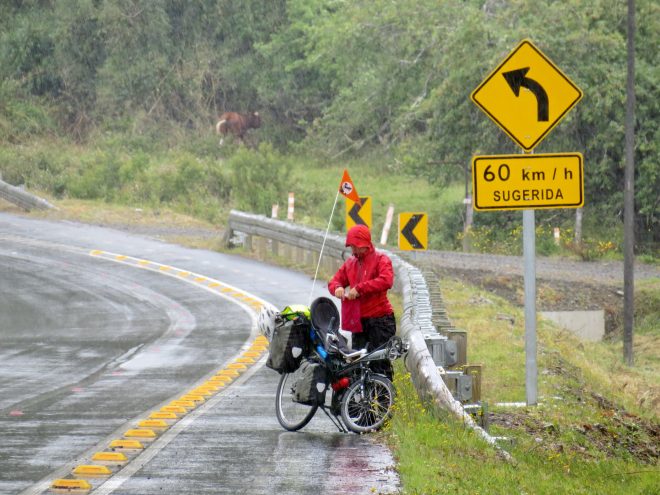
So, how was it?
This stretch of the Carretera Austral was beautiful, we would do it again and go back to do the rest of it all the way to the south. It was probably one of the most tiring roads in our whole trip, due to the steep climbs and constant ups and downs, the dirt roads and the frequent rain. We think that it’s worth taking enough time to cycle this part of the world to get the most out of it, meaning that you can sit out the rainiest days in a hospedaje or a campground. It’s also a great region to do a bit of hiking, and we would have liked having a bit more time for this. This part of the Carretera Austral is also easily accessible from Puerto Montt, and you can catch a ferry back there from several ports on the way. It’s therefore also a good place to explore for people who don’t have a lot of time – in 3 or 4 weeks you can cycle a nice stretch of the road.
After the beauty of the Carretera, we didn’t find much interest in cycling through Chiloé. The scenery was nothing very special (green rolling hills), and the main road was busy with cars and trucks. Chiloé is known for its wooden churches, but only a handful of them are actually restored, and they’re a bit out of the way if you’re cycling. For those who are interested in the culture of Chiloé, we would recommend exploring it by bus before cycling down the Carretera Austral from Puerto Montt, or else take a lot of time to cycle Chiloé’s back roads. But if you’re heading down the Carretera Austral, we would give Chiloé a miss, because we found the mainland so much more beautiful for cycle touring.
